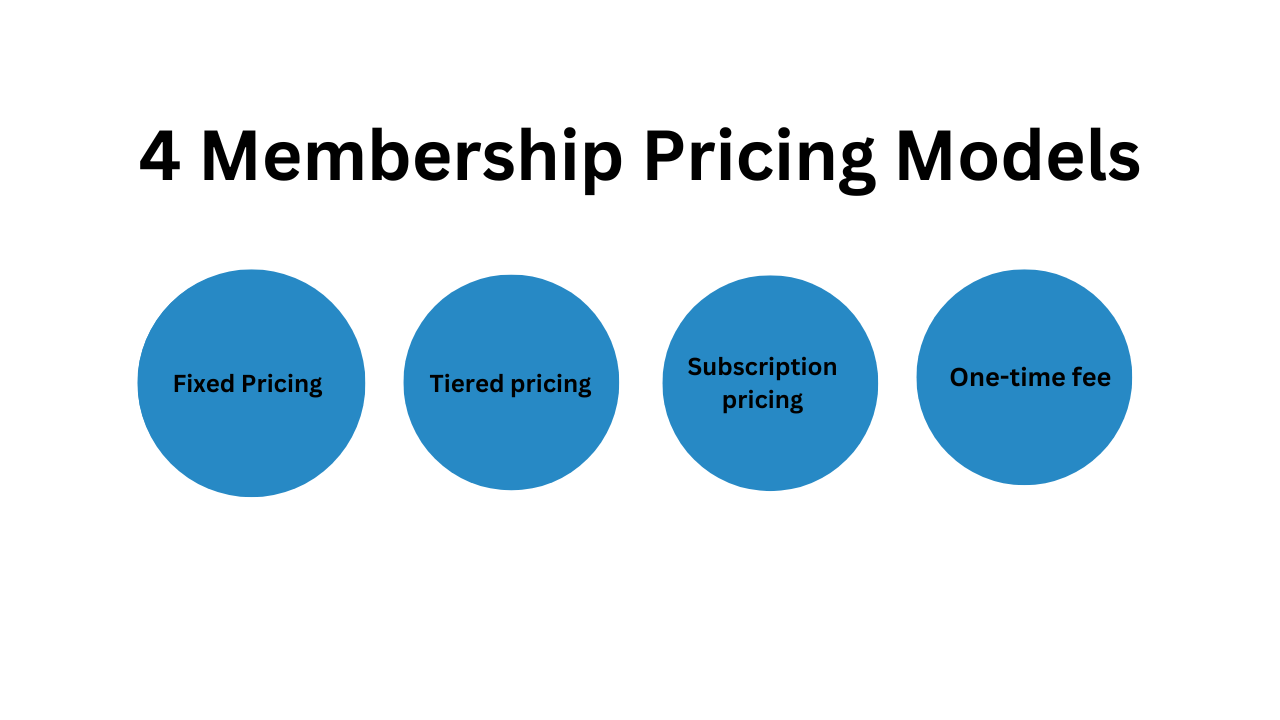Welcome to the world of membership platforms, where the art of pricing becomes a strategic dance. In this guide, we’ll simplify the complexity of membership pricing tactics, offering you a clear roadmap to navigate the choices at your disposal.
From freemium models to tiered structures, we’ll explore four effective approaches that can redefine how you monetize your membership platform and membership Pricing. Whether you’re just starting or looking to optimize your current strategy.
These straightforward methods aim to demystify the pricing puzzle and empower you to make decisions that resonate with your audience and align with your platform’s goals. Join us on this journey as we unveil the secrets behind successful membership pricing and pave the way for your platform’s prosperity.

Quick Links
What Is A Membership Pricing Strategy?
A membership pricing strategy is a structured approach to determining the fees or charges associated with accessing a membership-based product, service, or platform. It involves making thoughtful decisions about how to monetize the value offered to members. This strategy typically takes into account factors such as the target audience, the perceived value of the membership, and the overall goals of the organization or business.

Key Elements of a Membership Pricing Strategy:
1. Pricing Models: Choose from various models like freemium, tiered pricing, or one-time payments based on what aligns best with your offering.
2. Member Segmentation: Tailor pricing tiers to cater to different segments within your audience, offering options that suit varying needs and budgets.
3. Perceived Value: Establish a clear understanding of the value proposition for members, ensuring that the pricing reflects the benefits and features provided.
4. Competitive Analysis: Consider industry standards and competitor pricing to position your membership offering competitively within the market.
5. Flexibility: Build flexibility into your pricing strategy, allowing for adjustments based on market trends, member feedback, and changes in the value of your offerings over time.
6. Communication: Clearly communicate the benefits of each pricing tier to potential members, helping them make informed decisions.
Ultimately, a well-crafted membership pricing strategy aims to strike a balance between attracting a loyal membership base and generating sustainable revenue for the continued growth and success of the membership-based business or platform.
Types Of Pricing Strategies
Let’s review the most popular price techniques that you can use when choosing which pricing model will work best for your company.

Market-Based Pricing
Market-based pricing refers to a calculated strategy that bases a product or service’s price on the competitive environment and current state of the market. Market-based pricing takes into account the external elements that affect a product’s perceived value by consumers, as opposed to cost-based pricing, which is based on the internal costs of production.
Setting prices in line with what consumers are prepared to pay while accounting for the dynamics of supply and demand within a particular market is the main tenet of market-based pricing. This approach acknowledges that consumer preferences, rival pricing, and general market trends can all affect how valuable a product or service is viewed.
Here are key components and considerations associated with market-based pricing:
- Market Research: Market-based pricing requires comprehensive market research to be conducted. Analyzing consumer behavior, tastes, and expectations is necessary for this. Businesses can effectively position their services by recognizing unique selling points and understanding how competitors price comparable things.
- Customer Value Perception: In market-based pricing, the focus is on how customers see the value of a product or service. Businesses should highlight features that matter most to their target audience, as these directly impact perceived value.
- Competitor Analysis: Analyzing competitors’ pricing is vital for market-based pricing. Businesses must assess industry benchmarks to decide if their product offers superior value, justifying a premium price, or if a lower price is needed for a competitive advantage.
- Price Elasticity: Recognizing price elasticity is crucial for market-based pricing. It gauges how responsive product demand is to price changes. Products with inelastic demand tolerate price increases, while those with elastic demand may experience a notable sales decline with higher prices.
Value-Based Pricing
Value-Based Pricing is a strategic pricing approach that sets the price of a product or service based on its perceived value to the customer rather than the cost of production. This method takes into consideration the benefits and unique attributes of the offering, aligning the price with what customers are willing to pay for the value received.
Here are key features of Value-Based Pricing:
- Customer-Centric: Focuses on understanding and satisfying the needs and preferences of customers.
- Perceived Value: Pricing is determined by the perceived value of the product or service in the eyes of the customer.
- Market-Oriented: Takes into account market conditions, competitor pricing, and the overall economic environment.
- Customization: Allows for flexibility in pricing based on variations in customer segments, usage patterns, or special features.
- Profit Optimization: Aims to maximize profitability by capturing a share of the economic value created for the customer.
- Differentiation: Emphasizes the unique features and benefits of a product or service that distinguish it from competitors.
4 Membership Pricing Models
The previously mentioned methods of membership Pricing are designed to assist you to identify the appropriate price point for your membership business. Let’s now discuss charging by studying a few typical membership pricing models:

1. Fixed Pricing
Fixed pricing is a straightforward and consistent pricing strategy where a set, unchanging price is established for a product or service. Unlike variable or dynamic pricing models, the fixed pricing approach means that the cost remains constant, regardless of external factors such as demand fluctuations or changes in production costs.
Here are key characteristics and considerations related to fixed pricing:
- Stability: The primary characteristic of fixed pricing is its stability. Once a price is set, it remains constant over a specified period, offering predictability for both the seller and the consumer.
- Simplicity: Fixed pricing is easy to understand for customers, as there are no complexities or fluctuations. The simplicity of this model can be attractive to consumers who prefer straightforward transactions.
- Risk Mitigation: Businesses employing fixed pricing can mitigate certain risks associated with market volatility. It provides a level of protection against sudden changes in costs or market conditions.
- Consumer Confidence: Fixed pricing can enhance consumer confidence by providing transparency and consistency. Customers know what to expect and can plan their budgets accordingly.
- Competitive Positioning: While fixed pricing may lack the flexibility of dynamic models, it can be a strategic choice for businesses aiming to position themselves as reliable and transparent within their market.
2. Tiered pricing
Tiered pricing is a membership Pricing model where a product or service is offered at different price points, or tiers, based on various features, functionalities, or levels of service. Each tier corresponds to a specific set of offerings, and customers can choose the tier that best aligns with their needs or preferences. This model is commonly used to cater to a diverse customer base and provide options that appeal to different segments.
key characteristics of tiered pricing:
- Multiple Tiers: Offered in distinct packages or levels.
- Gradation of Features: Higher tiers include all features of lower tiers and add more advanced ones.
- Scalability: Customers can choose a tier based on evolving needs.
- Customization: Pay for specific features, providing a tailored solution.
- Value Proposition: Each tier aligns with a unique perceived value.
- Price Differentiation: Tiers are priced differently based on functionality.
- Customer Segmentation: Facilitates categorization by preferences and willingness to pay.
3. Subscription pricing
A business strategy known as membership pricing allows clients to receive a product or service by paying a set amount on a regular basis, usually once a month or once a year. Because it can provide steady revenue streams and cultivate enduring client connections, this model is widely used across a range of sectors.
Subscription pricing is becoming common in a variety of industries, including software, entertainment, publishing, and more. It offers customers convenience and continuous value while giving businesses a flexible and profitable revenue strategy.
key characteristics of Subscription pricing:
- Recurring Payments: Customers pay at regular intervals (e.g., monthly, annually).
- Value Proposition: Emphasizes ongoing value, including updates and access to new features.
- Predictable Revenue: Provides stability for businesses in forecasting and planning.
- Customer Retention: Encourages loyalty, reduces churn, and may offer incentives for long-term commitments.
- Scalability: Scales well with business growth as new subscribers contribute to recurring revenue.
- Trial Periods/Free Versions: Attracts new customers with trial periods or free versions to experience the product or service.
- Challenges: Businesses must consistently deliver value to justify ongoing costs and maintain customer satisfaction.
4. One-time fee
A one-time fee pricing model involves charging customers a single, upfront payment for access to a product or service. Unlike subscription-based models, where customers pay regularly at predefined intervals, a one-time fee grants customers perpetual or time-limited access to the offering.
key characteristics of One-time fee pricing:
- Single Payment: Customers make a single payment at the time of purchase, typically for unlimited or specified access to the product or service.
- Ownership: Customers often own the product outright or have indefinite access, depending on the terms of the purchase.
- No Recurring Charges: Unlike subscription models, there are no ongoing payments, making it a straightforward and transparent pricing structure.
- Common for Tangible Goods: Commonly used for physical products, software licenses, downloadable content, and certain types of services.
- Fixed Price: The price is fixed and predetermined, providing customers with clarity on the cost of the product or service.
How To Set Membership Prices
Membership Pricing involves careful consideration of various factors to ensure that the pricing strategy aligns with the value offered, attracts customers, and sustains the financial health of the business. Here are steps to guide you in setting membership prices:
Understand Your Costs: Calculate the costs associated with providing the products or services included in the membership. This includes production, maintenance, support, and any other relevant expenses.
Define Value Proposition: Clearly articulate the value proposition of your membership. Understand what benefits and features will be included and communicate this value to potential customers.
Conduct Market Research: Research competitors and industry standards to understand what similar memberships are priced at. This will help you position your offering competitively.
Segment Your Audience: Identify different customer segments and their preferences. Consider offering tiered memberships to cater to varying needs and budgets.
Consider Perceived Value: Align the price with the perceived value of your offering. Understand what your target audience is willing to pay for the benefits provided by the membership.
Factor in Customer Acquisition and Retention Costs: Consider the costs associated with acquiring new members and retaining existing ones. This includes marketing expenses, customer support, and any loyalty programs.
Evaluate Profit Margins: Determine the profit margins you aim to achieve. Balance the need for profitability with the need to offer competitive pricing that attracts and retains customers.
Final thoughts on Membership Pricing Tactics: 4 Ways to Price Your Membership Platform
It’s critical to take into account your expenses, the actions of your competitors, and the values of your customers when setting the price of your membership platform. You can draw and retain members by providing several membership tiers, being aware of your target market, and being open and honest about your costs.
To maintain your platform’s performance and remain profitable, analyze and modify your pricing plan on a regular basis. Recall that a well-considered pricing strategy not only pays for itself but also adds value for your members, building a solid and long-lasting relationship.
Also read:-
How to Create a Private Social Network in 5 Easy Steps
7 Best Data Visualization WordPress Plugins For 2024

